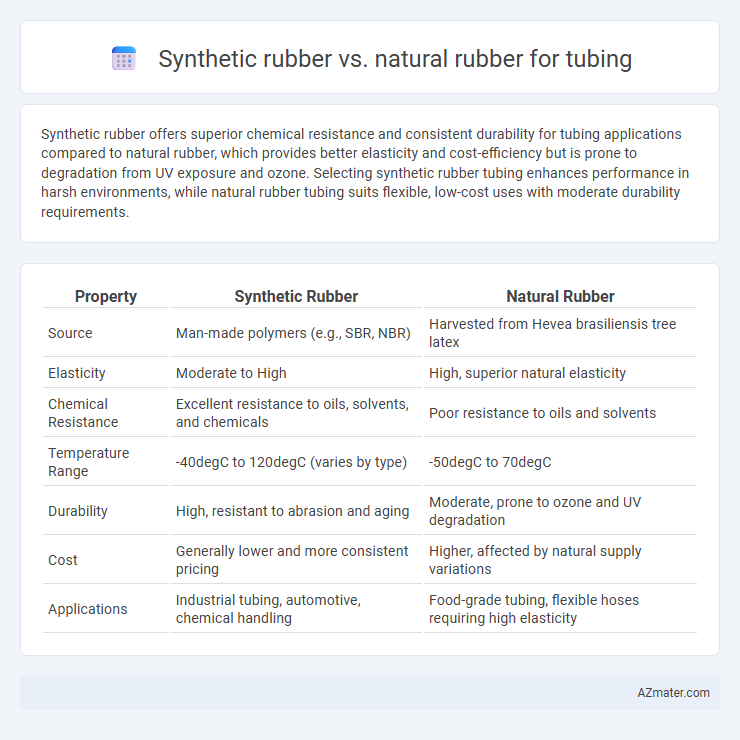Synthetic rubber offers superior chemical resistance and consistent durability for tubing applications compared to natural rubber, which provides better elasticity and cost-efficiency but is prone to degradation from UV exposure and ozone. Selecting synthetic rubber tubing enhances performance in harsh environments, while natural rubber tubing suits flexible, low-cost uses with moderate durability requirements.
Table of Comparison
| Property | Synthetic Rubber | Natural Rubber |
|---|---|---|
| Source | Man-made polymers (e.g., SBR, NBR) | Harvested from Hevea brasiliensis tree latex |
| Elasticity | Moderate to High | High, superior natural elasticity |
| Chemical Resistance | Excellent resistance to oils, solvents, and chemicals | Poor resistance to oils and solvents |
| Temperature Range | -40degC to 120degC (varies by type) | -50degC to 70degC |
| Durability | High, resistant to abrasion and aging | Moderate, prone to ozone and UV degradation |
| Cost | Generally lower and more consistent pricing | Higher, affected by natural supply variations |
| Applications | Industrial tubing, automotive, chemical handling | Food-grade tubing, flexible hoses requiring high elasticity |
Introduction to Synthetic and Natural Rubber Tubing
Synthetic rubber tubing offers enhanced resistance to chemicals, heat, and abrasion, making it ideal for industrial and medical applications requiring durability and flexibility. Natural rubber tubing provides excellent elasticity, tear resistance, and tensile strength, beneficial for applications needing high resilience and compression recovery. Selecting between synthetic and natural rubber tubing depends on specific environmental factors, performance requirements, and cost considerations.
Chemical Composition and Structure
Synthetic rubber used for tubing is primarily made from polymers such as styrene-butadiene rubber (SBR) or nitrile butadiene rubber (NBR), which consist of carefully designed synthetic monomers that provide consistent chemical resistance and durability. Natural rubber, derived from polyisoprene sourced from Hevea brasiliensis trees, features a cis-1,4-polyisoprene structure that offers excellent elasticity but lower resistance to solvents, oils, and chemicals. The molecular uniformity in synthetic rubber enhances predictability in performance, while the natural rubber's irregular molecular structure imparts superior flexibility and tensile strength under mechanical stress.
Manufacturing Processes
Synthetic rubber for tubing is produced through polymerization of monomers such as styrene and butadiene, enabling precise control over molecular composition and properties, which enhances consistency and performance in industrial applications. Natural rubber is harvested as latex from rubber trees and undergoes processes like coagulation, drying, and vulcanization to improve elasticity and durability, but it may exhibit variability due to environmental factors. Manufacturing synthetic rubber tubing often involves extrusion or molding with additives for specific resistance characteristics, whereas natural rubber tubing relies on refined processing techniques to retain its inherent flexibility and strength.
Physical and Mechanical Properties Comparison
Synthetic rubber tubing offers superior resistance to abrasion, chemicals, and temperature variations, making it ideal for industrial applications requiring durability and flexibility. Natural rubber tubing provides excellent elasticity, tensile strength, and tear resistance, which are crucial for dynamic environments and impact absorption. Comparing tensile strength, synthetic rubber typically ranges from 10 to 25 MPa, while natural rubber can reach up to 28 MPa, but synthetic variants excel in prolonged environmental stability and aging resistance.
Resistance to Chemicals and Environmental Factors
Synthetic rubber tubing offers superior resistance to a wide range of chemicals, including oils, acids, and solvents, making it ideal for industrial and chemical applications. Natural rubber tubing, while flexible and elastic, is more susceptible to degradation from ozone, UV light, and certain chemicals like petroleum-based products. Choosing synthetic rubber enhances durability and longevity in harsh environmental conditions where chemical exposure and weathering are prevalent.
Flexibility and Durability in Applications
Synthetic rubber tubing offers superior durability in harsh chemical and temperature environments compared to natural rubber, which excels in flexibility and elasticity for dynamic applications. Natural rubber provides excellent tensile strength and resilience, making it ideal for tubing requiring repeated bending or stretching without cracking. Synthetic variants like neoprene and silicone withstand abrasion and ozone degradation better, ensuring long-lasting performance in industrial and medical tubing applications.
Cost Analysis and Economic Considerations
Synthetic rubber tubing generally offers lower and more stable pricing due to controlled manufacturing processes and raw material availability, while natural rubber tubing prices fluctuate based on agricultural yields and climate conditions. Cost analysis highlights synthetic rubber's advantage in mass production economies and longer shelf life, reducing replacement and maintenance expenses. Economic considerations also include synthetic rubber's resistance to chemicals and temperature extremes, which can decrease total operational costs compared to natural rubber tubing in demanding environments.
Environmental Impact and Sustainability
Synthetic rubber for tubing, derived primarily from petrochemicals, has a higher carbon footprint and limited biodegradability compared to natural rubber, which is a renewable resource harvested from rubber trees. Natural rubber exhibits superior sustainability due to its biodegradability and capacity for carbon sequestration during tree growth, making it an environmentally preferred choice for tubing applications. However, synthetic rubber offers consistent quality and resistance properties, necessitating a balance between performance requirements and environmental impact considerations.
Common Applications in Tubing Industries
Synthetic rubber, such as nitrile and EPDM, dominates tubing applications requiring high resistance to chemicals, oil, and temperature variations, making it ideal for automotive fuel lines, medical equipment, and industrial hoses. Natural rubber tubing excels in flexibility and resilience, commonly used in applications like food and beverage processing, air and water hoses, and agricultural equipment. The choice between synthetic and natural rubber tubing hinges on specific industry demands, including chemical exposure, temperature tolerance, and mechanical wear resistance.
Choosing the Right Rubber Tubing for Your Needs
Selecting the right rubber tubing depends on application-specific requirements such as chemical resistance, flexibility, and temperature tolerance. Synthetic rubber tubing, including materials like Nitrile and EPDM, offers superior resistance to oils, chemicals, and extreme temperatures, making it ideal for industrial and automotive uses. Natural rubber tubing provides excellent elasticity and abrasion resistance, suitable for general-purpose applications where flexibility and resilience are priorities.

Infographic: Synthetic rubber vs Natural rubber for Tubing
 azmater.com
azmater.com